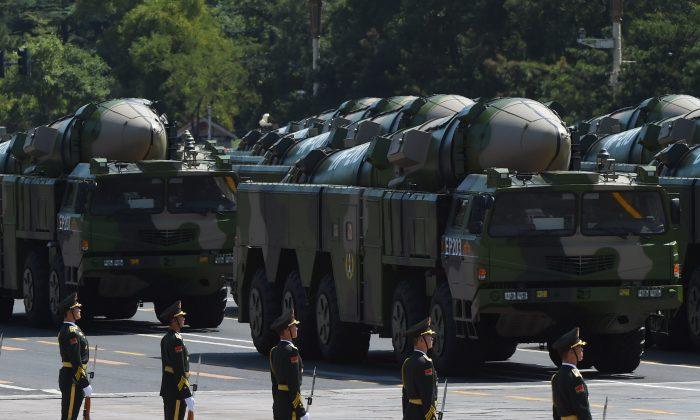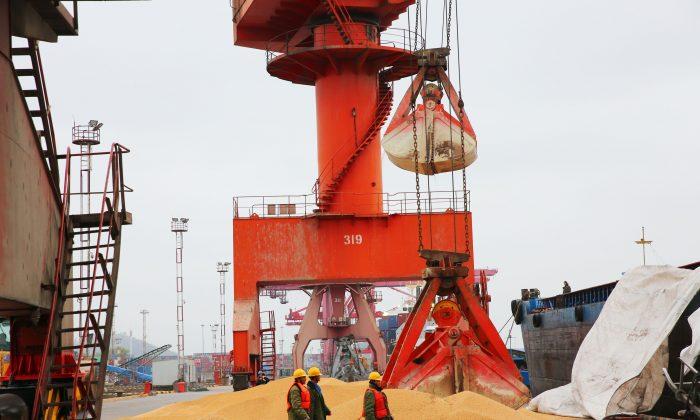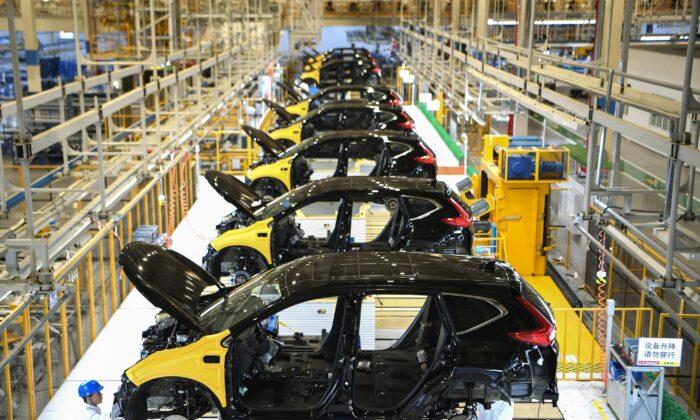News Analysis
The Washington-based think tank Center for Strategic and International Studies (CSIS) released a new report, detailing how China is moving to achieve world power through modernization of its nuclear land, sea, and air weapons.
China was the fifth nation to detonate a nuclear weapon, and is one of only nine nations that currently acknowledges having nuclear weapons. The 2006 Defense White Paper issued by the State Council claims Beijing has adopted a “self-defensive nuclear strategy” to deter attacks and prevent coercion, but Chinese officials privately indicated that a “conventional strike on China’s nuclear forces would provoke a nuclear response,” according to experts.
CSIS rates “China’s nuclear arsenal as relatively small compared to those of the United States and Russia” that operate a “triad” of land, sea, and air weapons. But China, as the world’s second-largest military spender in 2018, spent $250 billion. With nuclear weapons as a key military investment, its “defensive nuclear strategy may be revised.”
The combined nuclear capabilities of the United States and the Soviet Union at the height of the Cold War arms race was 64,000 warheads in 1986. The 1991 Strategic Arms Reduction Treaty (START), the 2002 Strategic Offensive Reduction Treaty, and the 2010 New START Treaty brought the superpowers’ warheads down to 8,290 in 2018. Given that many weapons contain multiple independent recovery vehicle warheads (MIRV), the United States is still dominant with 1,920 land, 850 sea, and 800 air nuclear weapons.
China detonated its first atomic device on Oct. 16, 1964. But as a non-signatory to the weapons reduction treaties, China is unconstrained from ramping up its arsenal and is now in third place with 290 weapons, including 218 land, 48 sea, and 20 air. China is considered to have only partial “triad status,” because it hasn’t focused on strategic bombers. This may change in 2025 when the Peoples’ Liberation Army (PLA) Air Force deploys its nuclear-capable Xian H-20 strategic stealth bomber. The new air-launch system has an 8,500-kilometer (5,282 miles) range and resembles the U.S. B-2 Spirit stealth bomber.
China maintained a series of underground facilities to shelter its nuclear and conventional weapons from enemy attack. But after the U.S. military demonstrated a quantum advancement in precision GPS strike capability against fortified underground bunkers in the 1991 Persian Gulf War, China built thousands of new tunnels.
China’s nuclear deterrent advanced from Dong Feng-5 (DF-5) liquid-fueled and silo-based intercontinental ballistic missiles in the early 2000s, to solid state and highly survivable mobile DF-31 ICBMs in 2006 with a maximum range of 7,200 kilometers. By 2007, the system was again ungraded to the DF-31A with a range of up to 11,200 kilometers. The DF-31A is similar to Russia’s RS-24, but doesn’t currently include Russia’s four MIRVed missiles.
China’s military modernization went into high gear in December 2015 when its nuclear and conventional missile forces transferred from the Second Artillery Corps to the PLA Rocket Force as an independent branch of China’s military.
China has since upgraded its PLA navy’s four Jin-class (Type-094) submarines that each carry 12 Julang-2 (JL-2) sea launched ballistic missiles that have a range of 8,000 to 9,000 kilometers. CSIS comments that China claims its JL-2s can carry only one warhead, but “some sources claim it can be MIRVed to carry three to eight warheads.” That compares to U.S. and British Trident II D-5 sea-launched missile that can deliver eight MIRVed warheads.
PLA Rocket Force unveiled its new road and rail mobile DF-41 in mid-2019 that is estimated to have a 12,000- to 15,000-kilometer range, the longest nuclear operating range in the world. DF-41 is rated as packing three MIRVed warheads, but CSIS states that “some estimates indicate the DF-41 could be MIRVed with up to 10 warheads.”
Defense Intelligence Agency Director Lt. Gen. Robert P. Ashley Jr. stated at a DIA conference in May 2019 that China is likely to “more than double” the size of its nuclear weapons stockpile over the next decade. The DIA warned that with more nuclear weapons, China could make an offensive policy change for its weapons to become “launch on warning” of a potential adversary launch.
The weak link to China’s nuclear weapons modernization and expansion plans is that it has only a 14-ton stockpile of highly enriched fissile material, enough to build only a couple hundred weapons, and far less than the 574.5 tons for the United States. But Russia announced shortly after an arms control conference in October 2019 that it is now assisting China to develop a missile attack early warning system.





